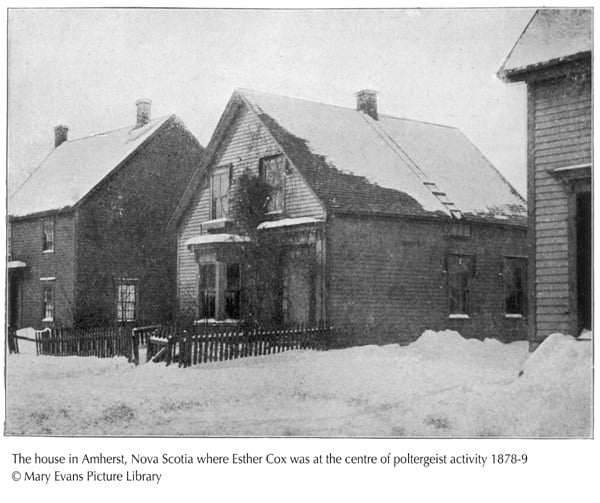The celebrated Amherst poltergeist mystery occurred between 1878 and 1879, and centred around an eighteen year old woman, Esther Cox, in a dwelling which housed her extended family.
The strange occurrences included knocking, banging and moving of objects, and eventually progressed onto fire-starting. Esther herself was frequently assaulted and was ultimately stabbed by a small knife.

An account of the key events was collected by actor Walter Hubbell, who came to investigate. It was published in 1879 as ‘The Haunted House, a True Ghost Story‘.
The book sold so well that it justified a short speaking tour by Esther. This evokes many other poltergeist cases, where phenomena start around an obscure girl /woman, but are catapulted into the public eye by a ‘facilitator’ – usually a man, and a person with more social ‘clout’, for example The Fox Sisters, Eleonore Zugun, and Enfield.
As the victim of an attempted sexual assault, Esther had good reason to be distressed prior to the strange events. We are also left to wonder about the family dynamics around this poltergeist ‘agent’. Hubbell tells us that Esther’s older sister, Jane, was “one of the village belles” while Esther herself was of “low stature and inclined to be rather stout” and “if asked to do anything she does not feel like doing she becomes very sulky”.
The phenomena stopped during a period when Esther was ill with diphtheria and when she left the Amherst house to stay with a married sister and a Captain James Beck. She stayed for a while with local people, the Whites, who were also free for three weeks ‘til the poltergeist visited them all.
She eventually went to work for a local man named Arthur Davison but the poltergeist’s pyromania made him suspicious when his own barn burned down. After spending a short spell in prison having been found guilty of arson, Esther the poltergeist left Esther alone.
It is apparent that the new-fangled religious movements of mesmerism and spiritualism affected perceptions of the case. Esther was thought by some to be able to hypnotise people in the same way that a woman from a previous generation may have been thought able to cast the evil eye. There were many attempts at Amherst – and on Esther’s travels – to communicate with the entity via rapping.
Not everybody believed in Esther’s ghost. Many of the locals dismissed it as attention-seeking. The most detailed critique came from Dr Walter F Prince in the Proceedings of the American Society for Psychical Research, Vol X111 of 1919. In his ‘A Critical Study of ‘The Great Amherst Mystery’. Prince pointed out that there were very few direct witnesses of the actual events, and he proposed ways that Esther herself could have created the whole thing with trickery. He clearly had some sympathy towards her as he thought she may have been in a dissociated state rather than simply being malignant.
Amherst today has made the most of its paranormal history with tourist events around Halloween called Esther Fest. Many thanks to Mary Evans Picture Library.

